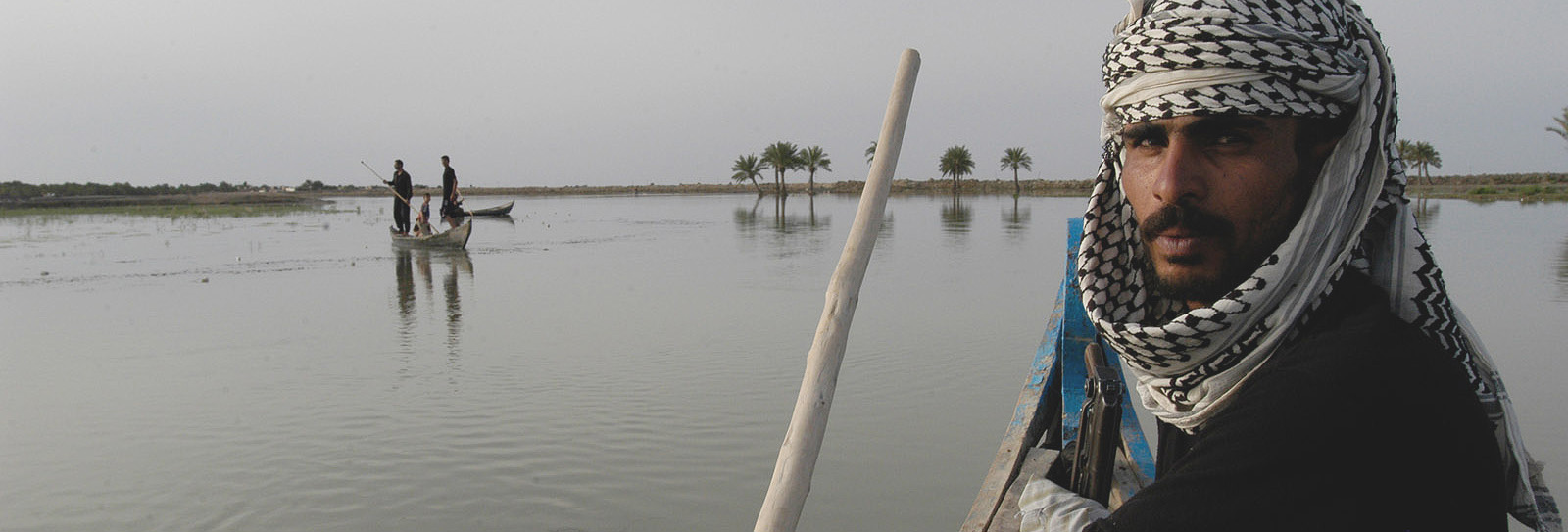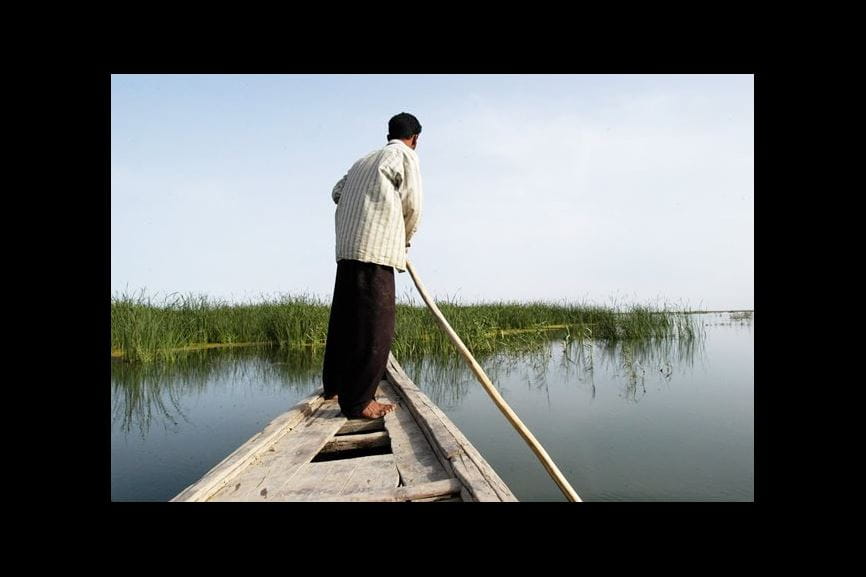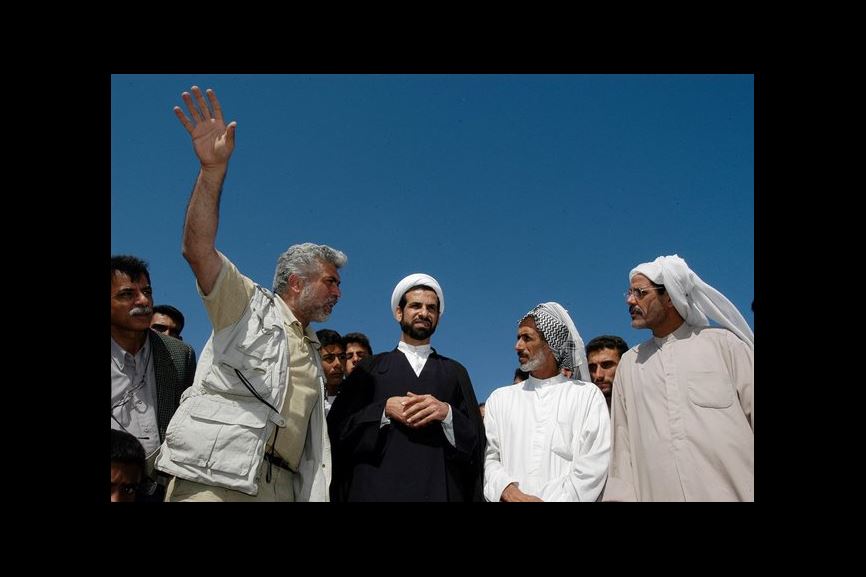
Reviving Eden
- History
- Science & Nature
- Conservation
Written by Pat McDonnell Iwair
Photographed by Dana Smillie
Originally published May/June 2004.
The moist, fertile delta where the Tigris and the Euphrates rivers converge in southern Iraq was Eurasia's largest wetland: two-thirds the size of Switzerland, larger than the Florida Everglades and roughly equal in area to Massachusetts. Its unique ecosystem has supported a unique human culture for at least 7000 years.

Its abundance of fish, wildlife and birds, together with soil suitable for growing barley, made possible the rise of the Sumerians and their city-states about 3000 BC.
A 5000-year-old engraved cylinder seal shows a house built of reeds that uses recognizably the same architecture that Iraq’s indigenous marsh dwellers, the Ma’dan people, used in the 20th century. These same reed houses also appear in a relief carved in the seventh century BC, during the reign of the Assyrian king Sennacherib, which shows men in battle among the famously impenetrable reed beds.
Around the same time, the marshes served as a haven for the Chaldeans, who defeated Sennacherib’s son Sargon II. In the ninth century of our own era, the Abbasid rulers of what is now Iraq couldn’t defeat the Zanj, a rebellious slave army that took refuge in the vastness of the wetlands. In their time, the Ottoman Turks proved unable to dominate the Ma’dan people, whose slim small boats gave them freedom of movement through the reeds. It was this protective aspect of the marshlands’ dense reed beds that, in the final decade of the 20th century, brought about their deliberate destruction.

In 1991, frustrated by stubborn political opposition in southern Iraq, Saddam Hussein launched a vast punitive assault that burned and poisoned the reed beds. He then built a system of locks, dikes, embankments and canals that turned the wetlands into a dust bowl. “It is absolutely phenomenal to see the destruction of an ecosystem on that scale in just five to six years,” says Hassan Partow of the United Nations Environmental Program (UNEP).
An estimated 250,000 Ma’dan people were killed or dispersed throughout Iraq and Iran. Many bird and animal species, some of them endemic to the marshes, were deprived of large portions of their range.
Few people outside the region can have been as heartsick over this as Azzam Alwash, a Los Angeles engineer whose father had been one of Iraq’s preeminent irrigation engineers. As a boy living in Baghdad, Alwash had often visited the marshes with his father and traveled through them in motorized boats as his father recorded water levels and inspected irrigation systems. Of all his father’s tasks, the marshes were his deepest passion, and they constituted some of Alwash’s fondest memories of the country he left in 1978. As the younger Alwash read of their destruction, the marshes became his passion, too.
In 2001, Alwash and his wife, Suzie, a geologist, founded Eden Again, a non-profit organization that plans for the revival of the marshlands. Alwash consulted his retired father, who shared his lifelong knowledge of river routes and estuaries to support the planning.

In Chubaish, the “Venice of Iraq,” a grand mudheif, or communal reception hall, has been built. It shows the strong, light, flexible arches of bundled reeds that are the most striking feature of the once common traditional architecture of the marsh tribes.
In 2002, Alwash received a grant from the us Department of State to construct computerized models simulating reflooding of the marshes. He also hosted a restoration planning workshop at the University of California at Irvine in early 2003 that 20 international experts attended. There, Dr. Thomas Crisman of the University of Florida called the Alwashes’ goal much more daunting than restoring the Florida Everglades—but achievable nonetheless.
The couple took their results to UNEP. And as the us invasion of Iraq grew imminent, they talked to government officials to persuade them not to bomb dams or dikes in the region: If new water flowed in too suddenly, Alwash knew, it would be contaminated by salt and toxins that had built up over the past decade, hampering future restoration.
In June of last year, Alwash resigned from his engineering firm and traveled to Baghdad as the project director of Eden Again, which now works closely with the Iraqi Ministry of Water Resources. His goal: to realize his plans to restore the Iraq marshes.

Kermashia Marsh has seen water again for nearly a year now. “Look at how dense it is!” exclaims Alwash. “It’s a jungle!”
One year into the project, Alwash is optimistic. Roughly 40 percent of the marshlands have been re-inundated, and some 20 percent of the original marsh population—about 6000 to 7000 Ma’dani families, or 42,000 people, he believes—have returned over the past year.
On the other hand, returning families have not all been able to settle on the sites they previously inhabited, and Ma’danis who had been forced to begin farming the drained marshlands may themselves be displaced by the new inundations. So there is a clear need for conflict resolution and detailed planning. But “only about 10 percent of the relocated people want to continue farming,” Alwash says. “At most, these agricultural experiments are no more than five or six years old. Farming practices are primitive: The yields are about one-fourth what they would be in the us. It is more practical for them to cultivate rice on the perimeters of the wetlands.”
Some parts were permanent marsh, others seasonal, but all, in flood, were a maze of channels and waterways, many made by driving buffalo through the reed beds when the water was low. There were also lakes large enough to lose sight of land on.

One of the man-made channels built during the 1990’s to drain the marshes was named the Glory River. Some displaced residents took refuge along its massive levees and earthworks. But their efforts to farm proved largely futile, and—after more than 6000 years of successful subsistence—most of the population became dependent on government social services.

Alwash talks with representatives of three marsh tribes in Amarah. “I’m more than an engineer. I’m a diplomat, a mentor, a counselor, a problem solver,” he says.
The traditional economy of the marshlands was based on fishing, reed weaving, production of water-buffalo dairy products and seasonal migrant farm work.
“Water buffalos are being brought back,” Alwash says with characteristic enthusiasm. “Their meat is no good, but their milk is rich, high in fat and protein. Water-buffalo gaimer [heavy top cream] fills the stomach for hours. Best of all, the buffalos forage for most of their food in the water, and need little or no supplemental feeding. Reeds are used for traditional house construction; almost no manufactured products are needed for housing. The mats the Ma’danis weave are bartered for necessary goods from the cities. And in late summer, the men traditionally hire themselves out to harvest rice and dates.”
Even though Alwash cautiously estimates that it will take five to six years for new waters to flush toxins and salts out of the newly inundated areas and establish an equilibrium, the perimeters of those areas in the Nasiriya region are recovering better than anticipated. Natural seed beds made the ecosystem resistant to periodic drought.
Less successful are the Kurmet Ali and Hawr al Adel regions, which cover more than 500 square kilometers (193 sq mi). “This is in the southern interior section, which never dried out,” he explains. “Reeds are not as thick there and it will require time to stabilize plant growth.”






Marsh residents, most of them recently returned to the Chubaish region from other parts of Iraq, include, top row from left, Zeinab Shaker, 16, Fuad el Khayoun, 58, and Khadim Khalifa Ziarra, 22; bottom row from left, Ikhlas, 11, Mohamed Ghazi, 77, and a girl who gave her name as Israh.
The quality of the water there is poor, too, with salinity ranging from 700 to 2500 parts per million (ppm)—three to 10 times the American maximum for drinking water. “That’s good enough for the reeds to grow,” Alwash says, “but not for human consumption,” and so drinking water is being imported in tank trucks in those areas. Meanwhile, a study is looking at using waste gas from the oil fields in the south, now flared off, to generate electricity to run desalination plants.
Alwash’s overall prognosis is for partial, but not full, recovery of the marshes. “We can never expect to restore all the original wetlands,” he says wistfully. Dams built far upstream, in southern Turkey, since the 1970s have reduced the water flowing into Iraq by more than 75 percent, while an international agreement between Syria and Iraq assures only that a minimum of 58.6 percent of the water that flows into Syria from Turkey will continue into Iraq.
His overall prognosis is for partial, but not full recovery of the marshlands. Upstream dams have reduced the flow of the Tigris and Euphrates by more than 75 percent.
“Ideally, an agreement among Turkey, Syria, Iraq and Iran to share the water in the river basins would be the long-term goal,” Alwash says. “The short-term solution is to restore the marshes with whatever water is available in southern Iraq. The medium-term answer is to improve irrigation techniques upstream in northern and central Iraq” to allow more water to flow to the marshes.

For now, Alwash finds the changes of the past year encouraging. “Ten percent of the original marshlands are in a robust stage of recovery,” he says. “The people are trickling back. The best news is that the Ma’danis, though they’ve been away for 10 years, are still proficient in reed weaving, reed-house construction techniques and water-buffalo husbandry. A 7000-year-old culture doesn’t die in a decade.”
The biggest outside assistance has been the eight to 10 million euros ($9.5–$12 million) that the Italian government has pledged toward a sustainable marsh program that will utilize water-management expertise developed in Venice. There is talk, Alwash says, of a sister-city relationship between the famously wet Italian port city and Chubaish, the economic heart of the marshes between Qurra and Nasiriya. Other help has come from UNEP, from the Canadian International Development Agency and from the us Agency for International Development, which sponsored research trips by wetlands experts such as Curtis Richardson of Duke University.
More good news came in December, he says, when the Iraqi minister of water resources announced that the restoration of the marshes was his ministry’s highest priority. “This shouldn’t have been surprising,” Alwash notes. “The marshes have always held a huge emotional pull for Iraqis, especially the Iraqis of the south.”
You may also be interested in...

Drones, Mangroves and Carbon Superpowers
Science & Nature
Mangroves have been drawing increasing global attention for a quiet superpower: the ability to store up to five times more carbon than tropical forests. While coastal development, uncontrolled aquaculture, sea-level rise and warming temperatures have all contributed to the 35 percent decline in mangrove forests worldwide since the 1970s, government agencies, scientists and local communities are increasingly rallying to protect and replant mangroves. One group is taking restoration to notably new heights.
The Return of the Karabakh Horse
Science & Nature
Strength, speed and a lustrous coat made the Karabakh horse a symbol of status, power and beauty in its native Azerbaijan, and beyond. Wars over the past century nearly eliminated them, but now breeders are steadily restoring their numbers.